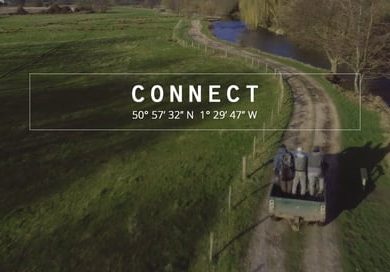Stealing the angle
.jpg) As with so much in fly fishing, it is largely a matter of finding the right angle on the fish, particularly in running water. Ideal dry fly presentation will have the fish at a nice easy up and across angle, where you can cast a metre or so upstream of the target, so that the fly drifts down over the fish’s station before drag can set in and ruin the cast, and so that only the fly is seen by the fish, not the leader or, worse, the fly line. So often, however, we do not have this ideal situation, particularly if we are wading. It takes time to manoeuvre into position, and it also causes disturbance. It is usually better by far to adapt your presentation, which means appropriate casting, to ‘steal’ a better angle on a fish.
As with so much in fly fishing, it is largely a matter of finding the right angle on the fish, particularly in running water. Ideal dry fly presentation will have the fish at a nice easy up and across angle, where you can cast a metre or so upstream of the target, so that the fly drifts down over the fish’s station before drag can set in and ruin the cast, and so that only the fly is seen by the fish, not the leader or, worse, the fly line. So often, however, we do not have this ideal situation, particularly if we are wading. It takes time to manoeuvre into position, and it also causes disturbance. It is usually better by far to adapt your presentation, which means appropriate casting, to ‘steal’ a better angle on a fish.
The downstream approach, with a parachute or stun cast, that I was writing about in the last piece was developed largely from a need to find this appropriate presentation. It simply opens up the possibilities for a wading fisherman from any particular stance in the entire surroundings of the river. To be more complete, if pedantic, about this, we obviously extend the idea to include an across and downstream approach. We have 360 degrees of opportunity here, largely accessed by having control of your casting and leader construction.

Casting a 20′ leader can be tricky. You cannot, for example, hope to turn over a dry fly on a long leader into the wind. And if the fly blows back over the leader or the fly line, it is useless. So, we are limited by wind direction with this approach. But we can also use the wind. If you arrive on the river hopeful for a nice bit of upstream dry fly fishing, and find a horrid down-streamer, then you are either going to have to persist with upstream presentation using a powerful forward cast with a low trajectory and a short leader – never easy to consistently get right, or you can think about the much easier downstream approach with the long leader. Keep a high stop point on the forward cast and the wind will do the presentation, and the casting, for you.
I don’t mean to be didactic about this, or suggest that there is only one way to get it right. Quite the opposite, actually, because the ‘ideal’ situation, described above, is seldom reality. We have to adapt our presentation and approach with every step taken in the river, with every fish we find, and there are all sorts of ways of achieving what we want. It is always a compromise, and it is always fascinating. It is problem solving, after all, and the solution involves a wild animal in a wild environment.
I guide a lot nowadays; all the way from beginners trying to catch their first trout, then grayling, all the way to coaching an experienced fisherman in a new technique. I catch myself, almost every time, saying that it is all about presentation, and, really, about getting the right angle on a fish. And on the great European rivers, I find that all the best anglers are primarily doing just this. No matter what the method (though it is most obvious with dry fly), they are prowling the river, not necessarily just searching for fish-holding water, but usually to achieve the right position in the river so as to present to fish at just the right angle.

Think about it. Think of that fish on its station, feeding naturally, and you need to catch it. The best way, always, is to put a fly where the naturals are: exactly where the fish is feeding, without imparting drag, or showing the fish any line, ideally so that you are in contact with the fly at the moment the fish takes, so that you can just tap the hook home. It is nearly always a compromise, of course. Often you don’t have the perfect angle and you have to force it, steal it. Standard roll and overhead casting is way too limiting. Ideally, you need to be able to put in change-of-direction casts such as snakes and Speys, as well as the ‘presentation’ casts, such as reach casts and reach mends, and be able to hybridise these according to the needs of the situation.
The best river anglers do this instinctively, but it is also something which can be learnt. In Europe, I see it all the time. I see the French and the Italians, the Czechs and the Poles, adopting positions in limited sections of river, putting in a range of presentations, so beautifully subtle, that I wonder why the British have taken so long to engage this prime necessity in presentation fishing.
If you are interested in fly-fishing expeditions with Jeremy to the San River in Poland please visit Pioneer Flyfishing and don’t forget to mention you saw this on Fish & Fly! Or closer to home he also guides in the Eden area up in the lakes – details at Wilderness Flyfishing

